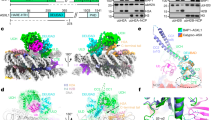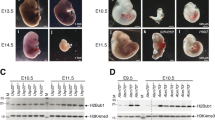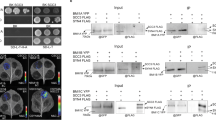Abstract
Polycomb group (PcG) proteins are transcriptional repressors that control processes ranging from the maintenance of cell fate decisions and stem cell pluripotency in animals to the control of flowering time in plants1,2,3,4,5,6. In Drosophila, genetic studies identified more than 15 different PcG proteins that are required to repress homeotic (HOX) and other developmental regulator genes in cells where they must stay inactive1,7,8. Biochemical analyses established that these PcG proteins exist in distinct multiprotein complexes that bind to and modify chromatin of _target genes1,2,3,4. Among those, Polycomb repressive complex 1 (PRC1) and the related dRing-associated factors (dRAF) complex contain an E3 ligase activity for monoubiquitination of histone H2A (refs 1–4). Here we show that the uncharacterized Drosophila PcG gene calypso encodes the ubiquitin carboxy-terminal hydrolase BAP1. Biochemically purified Calypso exists in a complex with the PcG protein ASX, and this complex, named Polycomb repressive deubiquitinase (PR-DUB), is bound at PcG _target genes in Drosophila. Reconstituted recombinant Drosophila and human PR-DUB complexes remove monoubiquitin from H2A but not from H2B in nucleosomes. Drosophila mutants lacking PR-DUB show a strong increase in the levels of monoubiquitinated H2A. A mutation that disrupts the catalytic activity of Calypso, or absence of the ASX subunit abolishes H2A deubiquitination in vitro and HOX gene repression in vivo. Polycomb gene silencing may thus entail a dynamic balance between H2A ubiquitination by PRC1 and dRAF, and H2A deubiquitination by PR-DUB.
This is a preview of subscription content, access via your institution
Access options
Subscribe to this journal
Receive 51 print issues and online access
We are sorry, but there is no personal subscription option available for your country.
Buy this article
- Purchase on SpringerLink
- Instant access to full article PDF
Prices may be subject to local taxes which are calculated during checkout




Similar content being viewed by others
Accession codes
Primary accessions
ArrayExpress
Data deposits
The microarray data have been deposited in the ArrayExpress database (http://www.ebi.ac.uk/arrayexpress) under the accession number E-TABM-908.
References
Schwartz, Y. B. & Pirrotta, V. Polycomb silencing mechanisms and the management of genomic programmes. Nature Rev. Genet. 8, 9–22 (2007)
Schuettengruber, B., Chourrout, D., Vervoort, M., Leblanc, B. & Cavalli, G. Genome regulation by polycomb and trithorax proteins. Cell 128, 735–745 (2007)
Müller, J. & Verrijzer, C. P. Biochemical mechanisms of gene regulation by polycomb group protein complexes. Curr. Opin. Genet. Dev. 19, 150–158 (2009)
Simon, J. A. & Kingston, R. E. Mechanisms of polycomb gene silencing: knowns and unknowns. Nature Rev. Mol. Cell Biol. 10, 697–708 (2009)
Pietersen, A. M. & van Lohuizen, M. Stem cell regulation by polycomb repressors: postponing commitment. Curr. Opin. Cell Biol. 20, 201–207 (2008)
Henderson, I. R. & Dean, C. Control of Arabidopsis flowering: the chill before the bloom. Development 131, 3829–3838 (2004)
Jürgens, G. A group of genes controlling the spatial expression of the bithorax complex in Drosophila . Nature 316, 153–155 (1985)
Gaytán de Ayala Alonso, A. et al. A genetic screen identifies novel polycomb group genes in Drosophila . Genetics 176, 2099–2108 (2007)
Nijman, S. M. B. et al. A genomic and functional inventory of deubiquitinating enzymes. Cell 123, 773–786 (2005)
Larsen, C. N., Price, J. S. & Wilkinson, K. D. Substrate binding and catalysis by ubiquitin C-terminal hydrolases: identification of two active site residues. Biochemistry 35, 6735–6744 (1996)
Amerik, A. Y. & Hochstrasser, M. Mechanism and function of deubiquitinating enzymes. Biochim. Biophys. Acta 1695, 189–207 (2004)
Jensen, D. E. et al. BAP1: A novel ubiquitin hydrolase which binds to the BRCA1 RING finger and enhances BRCA1-mediated cell growth suppression. Oncogene 16, 1097–1112 (1998)
Ventii, K. H. et al. BRCA1-associated protein-1 is a tumor suppressor that requires deubiquitinating activity and nuclear localization. Cancer Res. 68, 6953–6962 (2008)
Sinclair, D. A. R. et al. The Additional sex combs gene of Drosophila encodes a chromatin protein that binds to shared and unique Polycomb group sites on polytene chromosomes. Development 125, 1207–1216 (1998)
Johnston, S. C., Larsen, C. N., Cook, W. J., Wilkinson, K. D. & Hill, C. P. Crystal structure of a deubiquitinating enzyme (human UCH-L3) at 1.8 Å resolution. EMBO J. 16, 3787–3796 (1997)
Ji, H. & Wong, W. H. TileMap: create chromosomal map of tiling array hybridizations. Bioinformatics 21, 3629–3636 (2005)
Oktaba, K. et al. Dynamic regulation by Polycomb group protein complexes controls pattern formation and the cell cycle in Drosophila . Dev. Cell 15, 877–889 (2008)
Gambetta, M. C., Oktaba, K. & Müller, J. Essential role of the glycosyltransferase Sxc/Ogt in Polycomb repression. Science 325, 93–96 (2009)
Papp, B. & Müller, J. Histone trimethylation and the maintenance of transcriptional ON and OFF states by trxG and PcG proteins. Genes Dev. 20, 2041–2054 (2006)
Wang, H. et al. Role of histone H2A ubiquitination in Polycomb silencing. Nature 431, 873–878 (2004)
Lagarou, A. et al. dKDM2 couples histone H2A ubiquitylation to histone H3 demethylation during Polycomb group silencing. Genes Dev. 22, 2799–2810 (2008)
Weake, V. M. & Workman, J. L. Histone ubiquitination: triggering gene activity. Mol. Cell 29, 653–663 (2008)
Vassilev, A. P., Rasmussen, H. H., Christensen, E. I., Nielsen, S. & Celis, J. E. The levels of ubiquitinated histone H2A are highly upregulated in transformed human cells: partial colocalization of uH2A clusters and PCNA/cyclin foci in a fraction of cells in S-phase. J. Cell Sci. 108, 1205–1215 (1995)
Buchwald, G. et al. Structure and E3-ligase activity of the Ring–Ring complex of Polycomb proteins Bmi1 and Ring1b. EMBO J. 25, 2465–2474 (2006)
Henry, K. W. et al. Transcriptional activation via sequential histone H2B ubiquitylation and deubiquitylation, mediated by SAGA-associated Ubp8. Genes Dev. 17, 2648–2663 (2003)
Klymenko, T. et al. A Polycomb group protein complex with sequence-specific DNA-binding and selective methyl-lysine-binding activities. Genes Dev. 20, 1110–1122 (2006)
Beuchle, D., Struhl, G. & Müller, J. Polycomb group proteins and heritable silencing of Drosophila Hox genes. Development 128, 993–1004 (2001)
McGinty, R. K., Kim, J., Chatterjee, C., Roeder, R. G. & Muir, T. W. Chemically ubiquitylated histone H2B stimulates hDot1L-mediated intranucleosomal methylation. Nature 453, 812–816 (2008)
McGinty, R. K. et al. Structure-activity analysis of semisynthetic nucleosomes: mechanistic insights into the stimulation of Dot1L by ubiquitylated histone H2B. ACS Chem. Biol. 4, 958–968 (2009)
White, R. A. H. & Wilcox, M. Protein products of the Bithorax Complex in Drosophila . Cell 39, 163–171 (1984)
Celniker, S. E., Sharma, S., Keelanm, D. J. & Lewis, E. B. The molecular genetics of the bithorax complex of Drosophila: cis-regulation in the Abdominal-B domain. EMBO J. 9, 4277–4286 (1990)
Bolstad, B. M., Irizarry, R. A., Astrand, M. & Speed, T. P. A comparison of normalization methods for high density oligonucleotide array data based on variance and bias. Bioinformatics 19, 185–193 (2003)
Nekrasov, M. et al. Pcl-PRC2 is needed to generate high levels of H3-K27 trimethylation at Polycomb _target genes. EMBO J. 26, 4078–4088 (2007)
Fraterman, S., Zeiger, U., Khurana, T. S., Wilm, M. & Rubinstein, N. A. Quantitative proteomics profiling of sarcomere associated proteins in limb and extraocular muscle allotypes. Mol. Cell. Proteomics 6, 728–737 (2007)
Müller, J. et al. Histone methyltransferase activity of a Drosophila Polycomb group repressor complex. Cell 111, 197–208 (2002)
Francis, N. J., Saurin, A. J., Shao, Z. & Kingston, R. E. Reconstitution of a functional core polycomb repressive complex. Mol. Cell 8, 545–556 (2001)
Levine, S. S. et al. The core of the polycomb repressive complex is compositionally and functionally conserved in flies and humans. Mol. Cell. Biol. 22, 6070–6078 (2002)
Mason, D. E., Ek, J., Peters, E. C. & Harris, J. L. Substrate profiling of deubiquitin hydrolases with a positional scanning library and mass spectrometry. Biochem. 43, 6535–6544 (2004)
Thåström, A. et al. Sequence motifs and free energies of selected natural and non-natural nucleosome positioning DNA sequences. J. Mol. Biol. 288, 213–229 (1999)
Luger, K., Rechsteiner, T. J. & Richmond, T. Preparation of nucleosome core particle from recombinant histones. Methods Enzymol. 304, 3–19 (1999)
Acknowledgements
We thank T. Sixma and G. Buchwald for the gift of proteins, H. W. Brock, R. E. Kingston, B. Korn and B. Turner for plasmids, baculoviruses and antibodies, V. Benes, J. de Graaf, S. Müller and A. Riddell for technical support, and W. Huber and J. Gagneur for discussions. T.W.M. is supported by NIH grant RC2CA148354. J.C.S., A.G.A.A., K.O., N.L.-H. and J.M. are supported by EMBL and by grants from the DFG.
Author information
Authors and Affiliations
Contributions
Author Contributions J.C.S., A.G.A.A., K.O., N.L.-H. and J.M. conceived the project, designed and carried out the experiments, discussed and interpreted the data and prepared the manuscript. R.K.M. synthesized H2Bub1 in the laboratory of T.W.M., S.F. performed the mass spectrometry analysis in the laboratory of M.W.
Corresponding author
Ethics declarations
Competing interests
The authors declare no competing financial interests.
Supplementary information
Supplementary Information
This file contains Supplementary Figures 1-8 with legends and Supplementary Table 1. (PDF 2989 kb)
Supplementary Table 2
This table shows the chromosomal coordinates of PR-DUB-bound regions and assigned _target genes with gene ontology classifications. (XLS 667 kb)
Rights and permissions
About this article
Cite this article
Scheuermann, J., de Ayala Alonso, A., Oktaba, K. et al. Histone H2A deubiquitinase activity of the Polycomb repressive complex PR-DUB. Nature 465, 243–247 (2010). https://doi.org/10.1038/nature08966
Received:
Accepted:
Published:
Issue Date:
DOI: https://doi.org/10.1038/nature08966
This article is cited by
-
The UBP5 histone H2A deubiquitinase counteracts PRCs-mediated repression to regulate Arabidopsis development
Nature Communications (2024)
-
Structural and mechanistic basis for nucleosomal H2AK119 deubiquitination by single-subunit deubiquitinase USP16
Nature Structural & Molecular Biology (2024)
-
BAP1 as a guardian of genome stability: implications in human cancer
Experimental & Molecular Medicine (2023)
-
BAP1 promotes osteoclast function by metabolic reprogramming
Nature Communications (2023)
-
Prognostic and predictive biomarkers for immunotherapy in advanced renal cell carcinoma
Nature Reviews Urology (2023)



